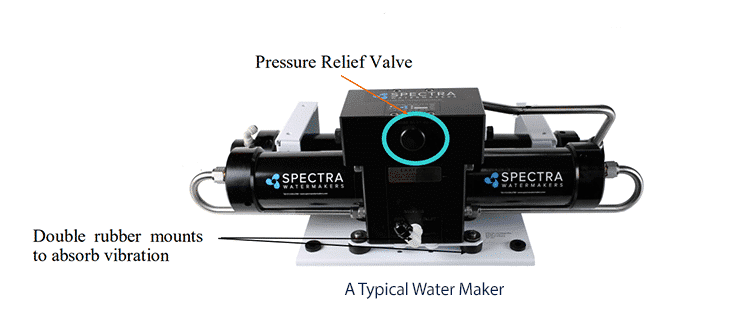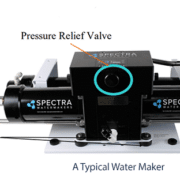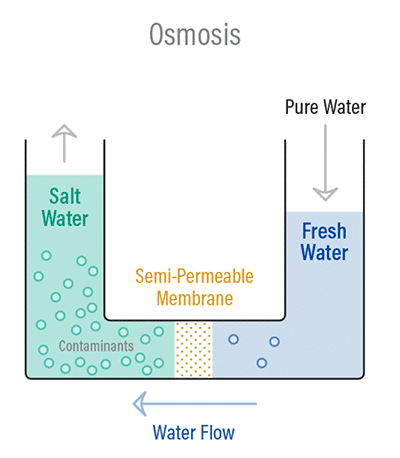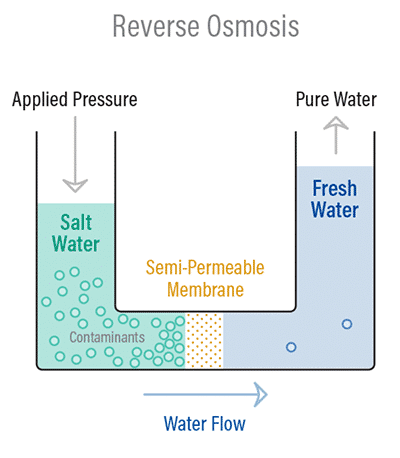Water and Water Making on Bareboat Charter
Water water everywhere and all the boards did shrink
Water water everywhere, nor any drop to drink
The Rime of the Ancient Mariner – Samuel Taylor Coleridge.
Above, is a famous quote about a man on a boat surrounded by ocean but with no drinkable water onboard. At home, water appears to be an endless supply – and it is cheap (relatively). To fill an entire swimming pool is of the order of $400. The average person, despite being told to drink 4 liters per day only drinks only about 2. The average size pool is about 60,000 liters. So it would take 30,000 days or 82 years to drink a pool dry. One glass at a time I guess!
Aboard, drinkable water is indeed a limited supply – very limited. Usually, a charter boat has enough water for about 3 days. Being really careful, you can extend that to 7 BUT no one is taking more than a 1 minute shower. On long trips such as ocean crossings, rationing has to be implemented. 3 liters to drink and 1 liter to wash. With say 5 people on a 15-day crossing, that is 300 liters (78 gallons). Many smaller sailboats don’t hold that much water. But the human body can not survive much longer than 3 days without water. Thus, the importance of understanding water rationing.
Body washing: Dive in the ocean to get wet, soap up (with biodegradable soap of course), and dive back in the ocean to rinse off. Now rinse off with minimal fresh water. Some soaps will “soap-up” with salt water – some don’t. Alternatively, you can just use buckets of salt water if you don’t want to dive in.
Showering: If you must – wet yourself down then TURN OFF THE WATER. Soap up and then rinse off.
Dishwashing: Clean off the dishes in salt water and give a quick rinse with fresh. Bucket salt water into the sink. Don’t use too much detergent because that takes extra water to wash off all those bubbles. You can even rinse off the soap with salt water then lightly rinse with fresh. Many dish sinks have a foot pump that draws water directly from the ocean. Make use of that! Buy only biodegradable dish soap.
Drinking: No one really wants to or even really should make a habit of drinking from the holding tanks on a boat. Especially a charter boat. It is likely that they have never been rinsed – who can say? Thus drinking water is usually brought on board in PLASTIC (yuck – plastic) bottles. If so please at least use the bigger plastic bottles which are typically more recyclable and require less plastic per liter of water than the individual-sized bottles. Also, larger bottles are refillable when you get an opportunity on shore. Many boats will have a drinking water filter connected to the holding tank.
Water Makers

The watermaker looks like this and will typically be mounted low in the boat. Typically, the on/off/standby/flush controller will be mounted near the electric control panel in the salon of the boat although sometimes in older models the control may be mounted directly on the unit.
Many charter boats are fitted with water makers. But you won’t guess the reason for this. Charter boats by the nature of chartering are mostly close to a land water source unless you charter in a remote destination such as La Paz, Mexico, or Placencia, Belize. So why the water maker on a charter boat? Are you ready for the reason?
By far the biggest damage to a charter boat is done in the marina – bumping into the docks. Charterers by nature are particularly bad at maneuvering purely because they get to practice once per year on their annual pilgrimage. Even if they own a boat at home, they typically charter a larger boat or even a catamaran which they are not used to handling with finesse.
When a charter boat is fitted with a water maker, it means that the charterers will go to fewer marinas to top up with water. Thus water makers are installed on charter boats to reduce damage. Wow! Ya didn’t see that one coming.
But perhaps you are chartering in La Paz or Placencia and you really need a water maker – or you want a remote charter vacation without going to the docks. Then a water maker is going to be a big legitimate plus for selecting which charter boat to rent. There is a BUT!
BUT water makers are notoriously high-maintenance devices. So chances are about 60/40 in your favor that the water maker will be working on your charter boat. That means a 40% chance it won’t work. That’s bad! And on arrival to the base when the base manager announces that your water maker is not working, there is really nothing you can do – except ask for the standard money back for the inconvenience. Some charter companies take their water maker maintenance more seriously some don’t. If you really want to increase your chances of your water maker to be working when you arrive at the base, speak to your yacht charter agent who has experience with which companies take maintenance more seriously. They know!
How a Water Maker Works
Watermakers use reverse osmosis to turn seawater into freshwater. Reverse osmosis is a pretty fancy word for running water through a fine filter where H2O can get through but other solute particles such as NaCl (Salt) can not.
You may remember from high school science what osmosis is. It is an amazing phenomenon. It operates on a universal law that a fluid wants to equalize its concentration with a connected adjacent fluid.
In the image below there is a semipermeable membrane. The membrane will not allow large solutes to pass.
Since the solutes can not pass from left to right to equalize the concentration, the only other way the universe can equalize the concentration of water is to pass more fresh water through to the saltwater in an attempt to dilute the saltwater. It is how plants absorb water from the ground through the plant root cell walls. There is such a propensity for the water to do this that it will overcome even the force of gravity. This is represented by the water level on the saltwater side being higher than the freshwater side. This is a wow and without the osmosis phenomenon, there would be no trees or plants.
Reverse osmosis is just the opposite. Pressure is applied to the Saltwater side. Since the solute NaCl can not pass through as well as other large molecules, only freshwater permeates. This increases the concentration of the salt water which is opposite of what the universal law of osmosis does. Thus like lifting something against gravity, it takes energy to do reverse osmosis.
Marine seawater reverse osmosis devices have a bountiful supply of salt water so the salt water side does not increase in concentration. Rather the “brine” (higher concentration water) is expelled back to the ocean while new seawater is brought on. Thus, a reverse osmosis device has two exits, brine plus fresh water, and one intake, salt water.
For fresh water to be delivered at any acceptable rate, the pump must create very high pressure which takes a lot of energy. Energy is also in a limited supply on a boat.
A Typical Water Maker
Water makers are rated by the amount of liters or gallons made per unit of time. The US-made Spectra water makers rate their product on gallons per 24 hours.
The Spectra 150 makes 150 US gallons per 24 hours – 6.3 gallons per hour – 24 liters per hour. Its weight is 27 kg – 60 lbs.
To supply the pressure required to force the seawater across the membrane, it consumes 9 amps of electric current when supplied at 12 v = 108 watts drain on the battery system.
Energy to Make Water
So how much valuable energy does it take to make the more valuable water using the Spectra 150 for example?
In one hour at 108 watts, you can make 24 liters. That is 108 Watt.hours of energy for 24 liters – 4.5 Watt.hours per liter. Thus to make 100 liters (26 gallons) it will take almost 1/2 of a kilowatt.hour.
For those not versed in energy, to provide perspective, to create 24 liters (in one hour) is about equivalent to 1/3 of the available energy stored in a normal 12 v marine battery. A decent-sized solar panel can produce enough energy in one day to run this water maker for 1 hour. Running the diesel engine for about 45 minutes can also produce the required amount of energy for the 24 liters.
Keep in mind that if running the engine to create enough energy, you are essentially exchanging the burning of diesel for the creation of fresh water. Again for perspective, to run a diesel engine for 1 hour takes about 2 liters of diesel (1/2 gallon) – $US3 (or so) – all for 24 liters or 6 gallons of water.
When you think about burning fossil fuels to make fresh water, it kinda makes you feel a little guilty and gives you the desire to be more respectful of responsible use of fresh water when aboard.
Perhaps, it also makes you want to be better at docking the boat to fill up from freshwater land-based supply when possible.
Practical Use of a Water Maker
If you own a water maker on your own boat, take particular care to read the manual regarding installation, winterizing, and consistent cleaning and flushing. All are important due to the delicate nature of all water makers.
If you are chartering a boat, pay particular attention during the boat briefing on how to use the specific water maker on your specific boat. All water maker brands do something different so pay attention. In particular, if the pressure is brought on manually during start-up, do it slowly so that you don’t overstress the membrane.
After making water, use the flush button. This removes the solute particles from the membrane and allows the water maker to run more efficiently.
You can drink the water safely directly from the water maker. If there is a spigot outlet then go ahead and refill your drinkable water storage bottles.
Don’t turn on the water maker in a marina as some bacteria will not be filtered. Watch the video below, don’t turn on the water maker when in a red tide or poor water quality situation.
Heave To(Time for a Break) It is time for a voluntary break. From time to time, we hand-pick videos from YouTube Channels that we follow and like to place in appropriate places in our course. You’re welcome to skip this if you are powering through but sometimes you need to give your brain a rest and see the WHY of your work here. In this video, watch our friends Tom and Peter from Sailing Bohemia struggling to run their water maker because of the “Red Tide”. They make a very good point about NOT running the water maker in suspect areas. |









